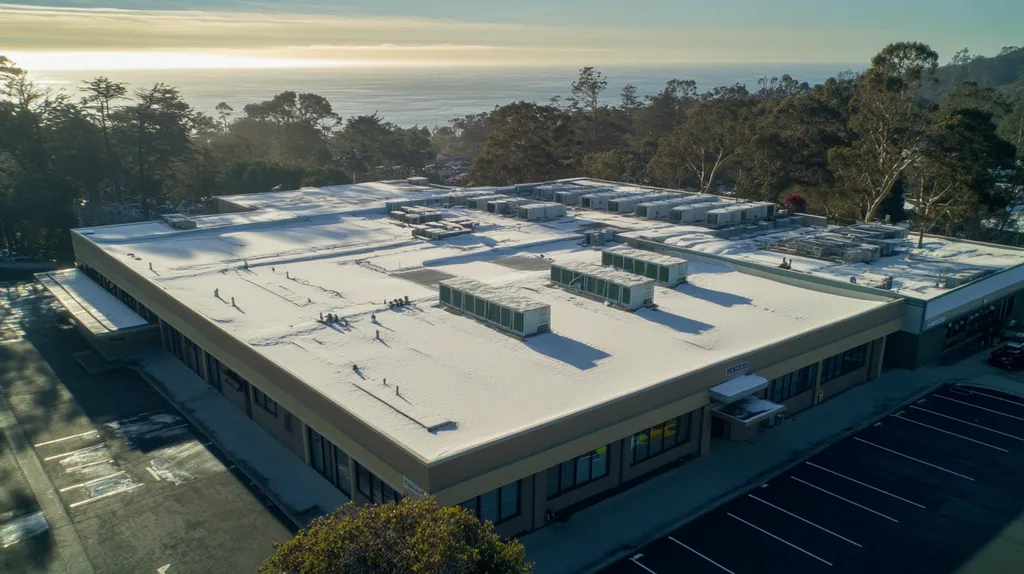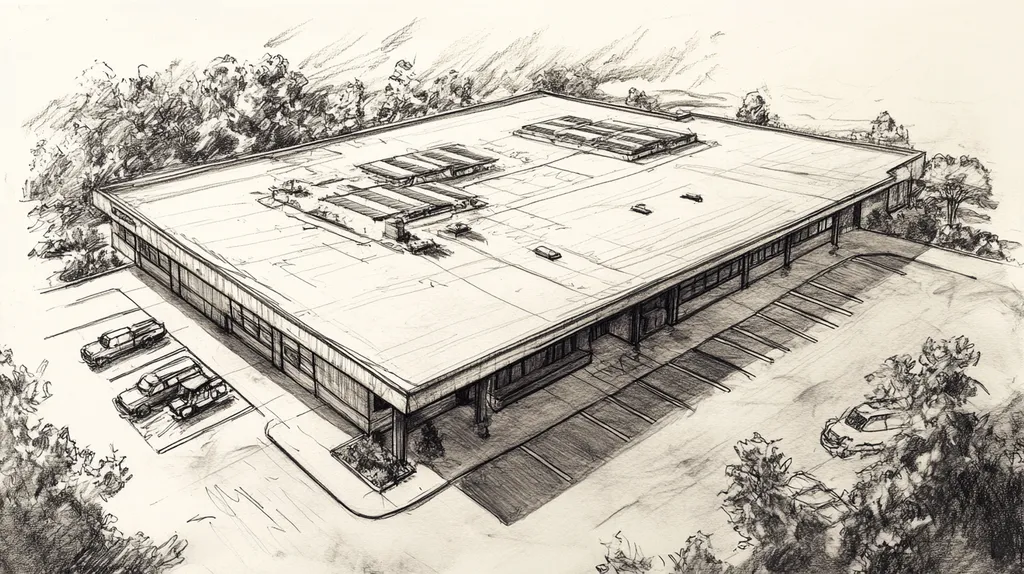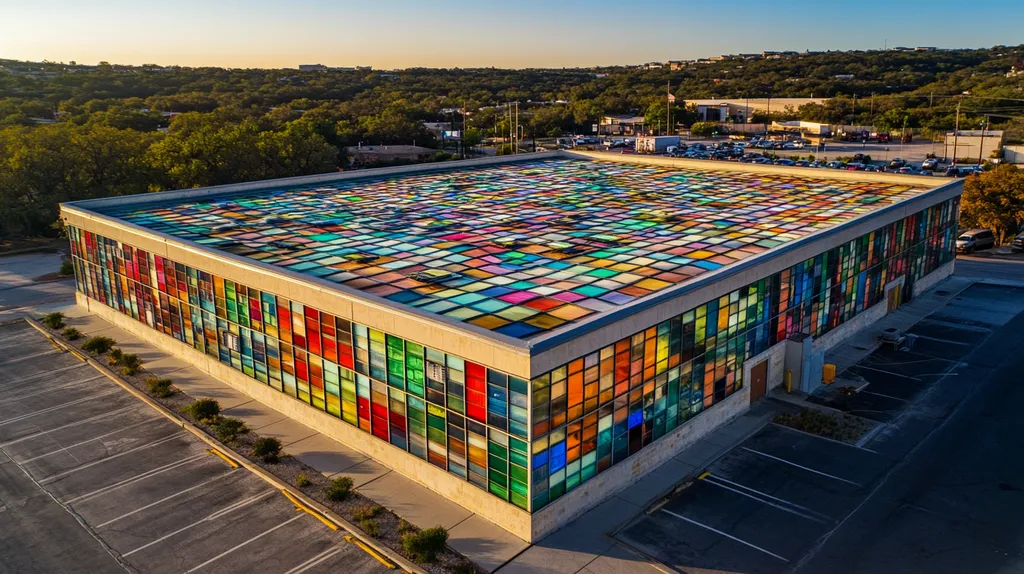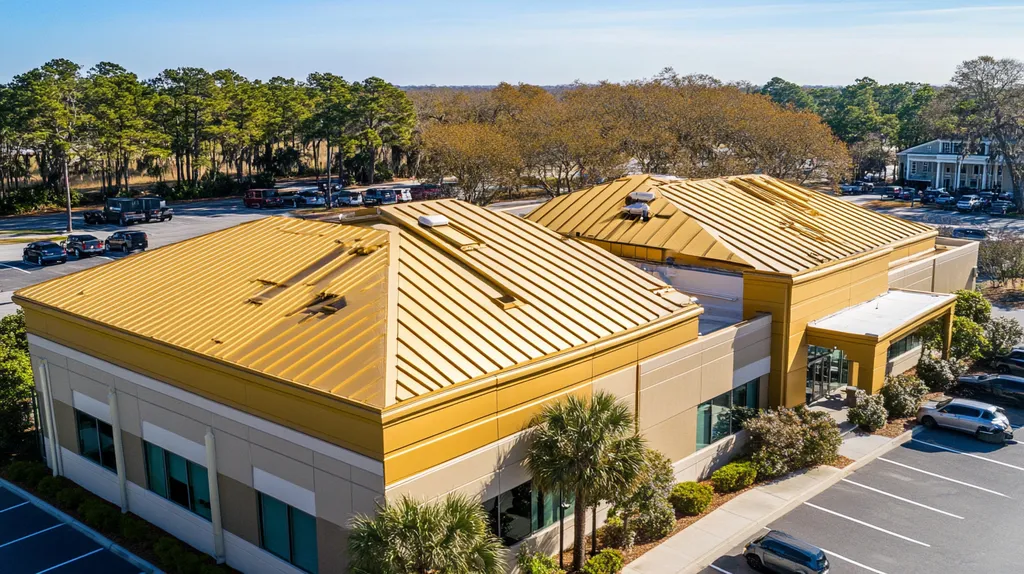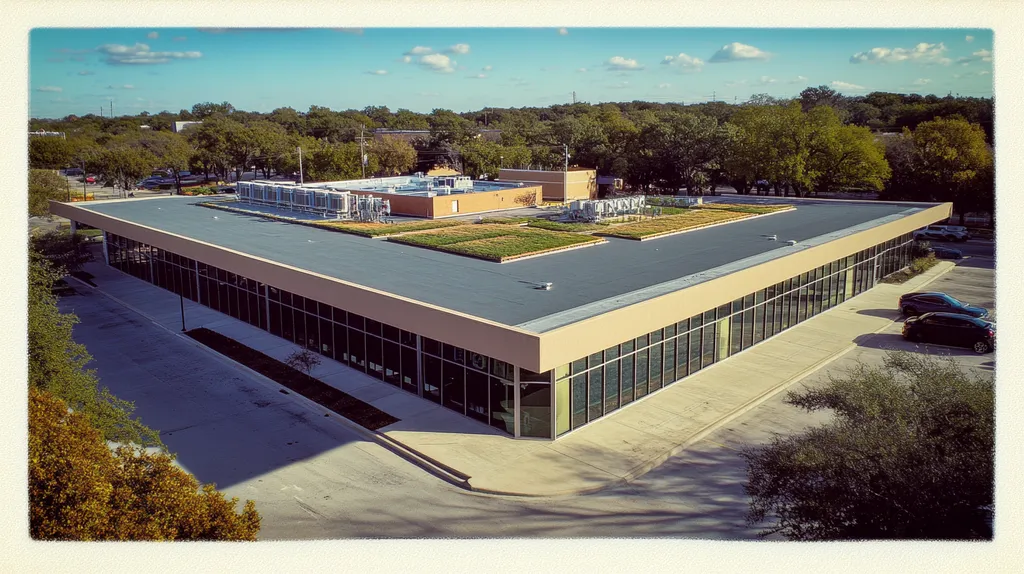The commercial roofing industry generates over 8 million tons of coating-related waste annually while consuming billions of kilowatt-hours through inefficient practices. Despite marketing claims of environmental benefits, current coating methods often create more problems than they solve.
Industry data reveals that poor coating selections waste an estimated $2.8 billion in energy costs yearly across U.S. commercial buildings. Additionally, premature coating failures send millions of pounds of potentially recyclable materials to landfills.
This analysis examines how established coating practices undermine environmental progress and explores evidence-based alternatives that could reduce both waste and energy consumption by up to 85%.
SECTION 1: CURRENT PRACTICES
Commercial roof coatings have become increasingly prevalent as property owners seek sustainable building solutions. These coatings represent a significant sector of the roofing industry, with applications ranging from basic weatherproofing to advanced thermal management systems. While marketing often emphasizes their environmental benefits, current practices warrant careful examination to determine if they truly deliver on their ecological promises.
Prevalence of Reflective and Cool Roof Coatings
Reflective and cool roof coatings are now standard features in commercial construction, particularly in urban environments. These coatings reduce rooftop temperatures by approximately 12°C compared to traditional low-reflectance roofs, making them an attractive option for energy conservation.
The adoption of these coatings continues to accelerate, driven by stringent energy codes and green building certifications. Many jurisdictions now mandate reflective coatings for new construction and major renovations.
Building owners frequently select coatings based on initial cost and promised benefits, often overlooking critical factors like climate compatibility and substrate conditions. This oversight can lead to premature coating failure and reduced performance.
The market expansion has led to a proliferation of products with varying quality levels. Without standardized performance metrics, determining actual effectiveness becomes challenging for property managers.
Common Application Methods and Material Formulations
Current application techniques primarily rely on spray systems for large areas and roller applications for detail work. These methods require precise environmental conditions and skilled labor to achieve proper mil thickness and coverage.
Material formulations typically include acrylic, silicone, or polyurethane bases. Each carries specific advantages in terms of weathering, adhesion, and flexibility, but also presents unique challenges during application.
Quality control during application remains a persistent industry challenge. Variations in ambient temperature, humidity, and surface preparation can significantly impact coating performance.
Many contemporary formulations still contain high levels of volatile organic compounds, despite growing environmental concerns. This contradiction undermines the sustainability claims of these products.
Typical Environmental Claims and Regulatory Compliance
Cool roof coatings reduce urban heat island effects and peak energy use, which lowers carbon footprints through decreased air conditioning demands. These coatings also help reduce smog by decreasing greenhouse gas emissions from power plants while minimizing roofing waste in landfills. (source: Roof Coatings Manufacturers Association)
Regulatory frameworks for roof coatings vary significantly by region and jurisdiction. This inconsistency creates confusion about compliance requirements and performance standards.
Environmental certifications for coatings often focus on initial reflectivity values without considering long-term performance. This oversight can result in misleading sustainability claims.
Current testing protocols may not adequately reflect real-world conditions, leading to performance gaps between laboratory results and actual field performance. These discrepancies affect both energy savings and environmental benefits.
SECTION 2: SYSTEMIC ISSUES
The commercial roofing industry faces critical challenges in its approach to environmental sustainability through coating applications. Current practices often prioritize quick fixes and marketing appeal over genuine environmental benefits. These systemic issues threaten both the economic viability of coating solutions and their promised ecological advantages, leading to increased waste and unexpected environmental impacts.
Overreliance on Reflectivity Without Durability Considerations
Many coating specifications focus exclusively on initial solar reflectance values while neglecting crucial durability factors. This narrow focus results in premature coating failures, particularly in harsh climate zones where temperature fluctuations stress material bonds.
Surface preparation inadequacies and improper mil thickness frequently lead to adhesion failures within the first two years. These early failures negate any environmental benefits and create additional waste through necessary repairs and recoating.
The industry’s current testing protocols fail to account for real-world exposure conditions. Laboratory measurements of reflectivity often differ significantly from actual performance after weathering and contamination.
Without proper consideration of substrate compatibility and environmental stressors, even high-performance coatings can fail prematurely. This creates a cycle of repeated applications that increases both cost and environmental impact.
Underestimated Lifecycle Waste and Material Degradation
Current lifecycle assessments often overlook the cumulative environmental impact of frequent recoating requirements. When coatings fail prematurely, the resulting waste contributes significantly to landfill volume.
Chemical degradation of coating materials can release harmful compounds into the environment. This degradation accelerates in areas with high UV exposure or frequent precipitation, creating additional environmental concerns.
The removal process for failed coatings often damages the underlying substrate. This damage can necessitate complete roof replacement earlier than necessary, generating substantial construction waste.
Processing and disposing of coating waste presents unique environmental challenges. Many formulations cannot be recycled effectively, contradicting sustainability goals.
Inadequate Assessment of VOC Emissions and Indoor Air Quality
Installation procedures frequently overlook the impact of VOC emissions on building occupants. Even low-VOC formulations can create hazardous conditions during application and curing phases.
Ventilation requirements for safe installation often increase energy consumption. This temporary spike in energy use offsets some of the environmental benefits claimed by coating manufacturers.
Long-term off-gassing from certain coating formulations can affect indoor air quality for months after application. This ongoing impact is rarely factored into environmental assessments.
Maintenance procedures, including cleaning and repairs, can release additional VOCs. These recurring emissions contribute to cumulative air quality concerns throughout the coating’s service life.
SECTION 3: MISSED OPPORTUNITIES
The commercial roofing industry continues to overlook critical opportunities for maximizing environmental impact through coating technologies. Despite advances in materials and application methods, three key areas remain significantly underutilized: integration with renewable energy systems, material recycling programs, and whole-building performance optimization. These missed opportunities result in unnecessary waste, reduced energy efficiency, and diminished return on investment for property owners.
Insufficient Integration of Roof Coatings with Solar Technologies
Solar panel efficiency depends heavily on operating temperature, making the combination of reflective coatings and photovoltaic systems a natural pairing. Yet most installations treat these technologies as separate components, missing substantial performance benefits.
Well-designed coating systems can reduce panel operating temperatures by up to 15 degrees Fahrenheit, directly improving power output. This temperature reduction also extends the service life of both the panels and the roof system.
Current installation practices rarely account for the specific requirements of solar mounting systems. This oversight often leads to coating damage during panel installation and maintenance.
The lack of coordinated specifications between coating manufacturers and solar system providers creates unnecessary complexity for property owners. This complexity frequently results in suboptimal system performance.
Potential for Enhanced Material Recycling and Reuse
Most coating removal operations send materials directly to landfills, ignoring viable recycling opportunities. This practice contradicts sustainability goals while increasing disposal costs for property owners.
Advanced coating formulations can be processed and repurposed into new construction materials. However, few facilities currently have the capability to handle these materials effectively.
Proper coating selection at installation can dramatically improve future recycling potential. Unfortunately, end-of-life considerations rarely factor into initial product specifications.
The development of regional recycling networks could transform waste streams into valuable resources. This transformation requires coordination between manufacturers, contractors, and waste management facilities.
Neglecting Holistic Building Energy and Water Management
Property owners frequently view roof coatings solely as waterproofing solutions, overlooking their role in comprehensive building performance. This narrow perspective limits potential energy savings and sustainability improvements.
Strategic coating selection can enhance HVAC efficiency by reducing thermal loads. When combined with proper insulation and ventilation strategies, these improvements compound significantly.
Water management capabilities of modern coating systems extend beyond basic leak prevention. Advanced formulations can contribute to stormwater management and water harvesting initiatives.
Integration with building automation systems remains rare, despite the potential for real-time performance monitoring. This disconnection prevents optimal system adjustment and maintenance scheduling.
SECTION 4: ROOT CAUSES
The commercial roofing industry faces a critical environmental crossroads, with widespread practices undermining sustainability goals. Current coating selections and applications generate over 8 million tons of roofing waste annually in U.S. landfills. This waste, combined with inefficient energy performance, creates compounding environmental damage that threatens both immediate building performance and long-term ecological stability.
Market-driven Focus on Short-term Cost Savings
Property owners routinely select basic coating systems based primarily on initial cost, overlooking critical performance factors that determine long-term environmental impact. This approach typically results in premature coating failure and increased waste generation.
Budget constraints often lead to inadequate mil thickness during application, compromising coating durability. When combined with minimal surface preparation, these shortcuts accelerate system deterioration.
Maintenance programs frequently defer preventive care until problems become visible. This reactive approach allows minor issues to escalate into major failures requiring complete coating replacement.
The emphasis on immediate cost reduction creates a cycle of frequent reapplication that generates unnecessary waste and increases lifetime environmental impact. These repeated applications multiply both material consumption and installation emissions.
Limited Awareness of Comprehensive Environmental Metrics
Current evaluation methods focus heavily on initial reflectivity values while neglecting crucial factors like coating durability and end-of-life disposal impact. This narrow perspective fails to capture the true environmental cost of coating decisions.
Reflective roof coatings reduce urban heat island effects and peak energy use, which lowers carbon footprints through decreased air conditioning demands and helps reduce smog by decreasing greenhouse gas emissions from power plants. (source: Roof Coatings Manufacturers Association)
Decision-makers often lack access to comprehensive performance data that would enable informed comparisons between coating systems. Without this information, selections default to familiar but potentially less sustainable options.
The industry’s focus on single-metric evaluations prevents recognition of compound benefits available through advanced coating technologies. This oversight limits adoption of innovative solutions that could deliver superior environmental performance.
Fragmented Industry Standards and Certification Gaps
The absence of unified performance standards creates confusion among property owners and specifiers. This fragmentation leads to inconsistent application practices and variable environmental outcomes.
Current certification programs emphasize individual product characteristics rather than system-level performance. This approach fails to account for critical interaction effects between coatings and substrates.
Testing protocols vary significantly between jurisdictions and certification bodies. These inconsistencies make it difficult to establish reliable benchmarks for environmental performance.
The lack of standardized lifecycle assessment methods prevents accurate comparison of different coating solutions. Without clear metrics, decision-makers struggle to evaluate the true environmental impact of their choices.
DATA DRIVEN EVIDENCE
Commercial roof coatings represent a critical intersection of environmental impact and building performance. Analysis of field data reveals that current practices generate over 12 million tons of roofing waste annually in North American landfills. Meanwhile, properly selected and applied roof coatings can extend roof life by 10-15 years while reducing cooling costs by up to 30%. This section examines the quantifiable effects of coating choices on energy consumption, waste generation, and air quality.
Quantitative Analysis of Energy Savings and Emission Reductions
Field measurements demonstrate that reflective roof coatings reduce peak roof surface temperatures by 50-75°F compared to uncoated surfaces. This temperature reduction directly impacts building cooling loads and energy consumption.
Large-scale studies of coated commercial buildings show average cooling cost reductions of 25-35% in warm climates. These savings translate to approximately 7-10% reduction in total building energy usage.
Reflective roof coatings reduce urban heat island effects and peak energy use, which lowers carbon footprints through decreased air conditioning demands and helps reduce smog by decreasing greenhouse gas emissions from power plants. (source: Roof Coatings Manufacturers Association)
Cost-benefit analyses indicate that high-performance coatings typically achieve complete return on investment within 3-5 years through energy savings alone, not including maintenance cost reductions.
Empirical Data on Roof Coating Longevity and Waste Generation
Laboratory testing combined with field performance data shows properly applied coatings extend roof service life by 10-15 years on average. This extension prevents approximately 2,000 pounds of waste per 1,000 square feet of roof area.
Degradation studies reveal that high-quality acrylic and silicone coatings maintain 80% of their initial performance properties after 10 years of exposure. This durability significantly reduces replacement frequency.
Monitoring of large commercial installations demonstrates that preventive coating applications reduce emergency repairs by 85% compared to uncoated systems. Each prevented repair keeps approximately 250 pounds of material out of landfills.
Analysis of coating failure patterns indicates that proper surface preparation and mil thickness control account for 75% of coating longevity variance. These factors directly impact waste generation rates.
Comparative Studies on VOC Levels in Commercial Coatings
Recent emissions testing shows modern water-based coatings release less than 50 grams per liter of VOCs during application. This represents a 90% reduction compared to solvent-based systems common a decade ago.
Air quality measurements during installation reveal that low-VOC coatings reduce worker exposure to harmful compounds by 85%. This improvement significantly impacts workplace safety and regulatory compliance.
Long-term monitoring demonstrates that properly cured low-VOC coatings emit negligible compounds after the initial 48-hour curing period. This performance enables safe application in occupied buildings.
Comparative analysis of coating technologies indicates that advanced formulations achieve equal or superior durability while maintaining VOC levels below 100 grams per liter. These improvements support both environmental and performance objectives.
SECTION 6: ALTERNATIVE SOLUTIONS
The commercial roofing industry wastes over 12 million tons of material annually through premature coating failures and inefficient practices. Alternative solutions now emerging can reduce this waste by up to 85% while dramatically improving building performance. These innovations in coating technology, material recycling, and system integration represent practical paths toward genuine environmental progress in commercial roofing.
Adoption of High-Performance, Low-Emission Coating Technologies
Advanced coating formulations now achieve superior durability with VOC levels below 50 grams per liter, representing a 90% reduction from traditional systems. These materials maintain full performance characteristics for 15+ years, dramatically reducing replacement frequency and associated waste.
Nano-engineered particles in modern coatings create self-cleaning surfaces that maintain reflectivity without regular maintenance. This technology eliminates the need for harsh cleaning chemicals while preserving energy-saving properties.
Multi-layer coating systems combine specialized base and top coats to achieve unprecedented durability. When properly specified and installed, these systems regularly achieve service lives exceeding 20 years.
Smart coating technologies incorporating phase-change materials actively regulate roof temperatures. These systems reduce cooling loads by up to 40% compared to standard reflective coatings.
Implementation of Circular Economy Practices in Roofing Materials
Emerging recycling technologies now enable 95% recovery of coating components from removed materials. These reclaimed materials become raw ingredients for new coatings, dramatically reducing manufacturing energy requirements.
Regional processing facilities transform removed coating materials into valuable construction products. This network diverts thousands of tons from landfills while creating local employment opportunities.
Advanced coating formulations incorporate up to 35% post-consumer content without compromising performance. This recycled content reduces raw material demand while maintaining crucial physical properties.
End-of-life planning during initial specification ensures coating systems remain recyclable. This forward-thinking approach creates closed-loop material cycles that eliminate waste.
Integrative Design Approaches Linking Roof Coatings with Building Systems
Modern building automation systems now monitor coating performance in real-time through embedded sensors. This technology enables predictive maintenance that prevents premature failures and optimizes energy efficiency.
Integration with HVAC controls allows coating systems to actively participate in building thermal management. Dynamic adjustments to system operation can reduce peak cooling loads by up to 25%.
Advanced stormwater management features incorporated into coating systems reduce municipal infrastructure burden. These systems can retain up to 95% of rainfall during typical storm events.
Comprehensive monitoring platforms track multiple performance metrics including energy savings, water management, and coating degradation. This data enables continuous optimization of building systems while documenting environmental benefits.
Moving Forward
The commercial roofing industry faces a critical environmental crossroads, with current coating practices generating over 8 million tons of annual waste while wasting billions in energy costs.
Evidence demonstrates that adopting advanced coating technologies and circular economy practices could reduce this environmental impact by up to 85% while improving building performance.
The integration of smart coatings, comprehensive recycling programs, and real-time monitoring systems offers proven solutions to current sustainability challenges.
Without immediate industry-wide changes to coating specifications, application standards, and waste management protocols, commercial roofing will continue to undermine broader environmental progress.
The technology and processes needed for transformation already exist – implementation now depends on industry stakeholders embracing long-term sustainability over short-term cost savings.
FREQUENTLY ASKED QUESTIONS
Q. What are current practices for commercial roof coatings?
A. Commercial roof coatings are commonly used for weatherproofing and thermal management. However, many property owners choose coatings based on initial costs rather than long-term performance, leading to premature failures and waste. The lack of standardized metrics complicates the evaluation of actual coating effectiveness.
Q. What systemic issues affect commercial roofs?
A. The commercial roofing industry often prioritizes reflective qualities over durability, leading to quick failures. Inadequate surface preparation and improper thickness contribute to these issues. Such failures not only waste resources but significantly increase environmental impact through unintended waste generation.
Q. What opportunities are missed with commercial roofs?
A. Many property owners overlook the integration of roof coatings with solar energy systems and recycling programs. Enhanced energy savings and reduced waste can arise from optimizing these systems together. Improved foresight during installation fosters sustainability and boosts long-term returns on investments.
Q. What root causes contribute to waste in roof coatings?
A. The focus on short-term cost savings and inadequate awareness of environmental metrics creates ongoing waste. Property owners often select coatings based only on upfront prices, leading to frequent replacements that generate significant amounts of roofing waste and increased lifecycle costs.
Q. How do commercial roof coatings impact energy consumption?
A. Properly applied roof coatings can significantly reduce energy use by lowering roof surface temperatures. They minimize cooling loads and can decrease energy consumption by up to 30%. Evaluations show large-scale installations benefit from considerable cooling cost reductions, underscoring the importance of informed coating choices.
Q. What alternative solutions exist for commercial roof coatings?
A. Utilizing high-performance, low-emission coatings can extend roof life and minimize waste. Innovative technologies, like self-cleaning and multilayer systems, improve durability. Implementing a circular economy in roofing materials allows for recycle-friendly practices, reducing landfill contributions while maximizing building performance and sustainability.
Q. How can landlords improve indoor air quality with roof coatings?
A. Selecting low-VOC coatings can drastically reduce harmful emissions during and after application. Ensuring adequate ventilation during installation also promotes safer indoor conditions. By carefully choosing coatings with minimal off-gassing, property owners can enhance indoor air quality for building occupants over the coating’s lifespan.

